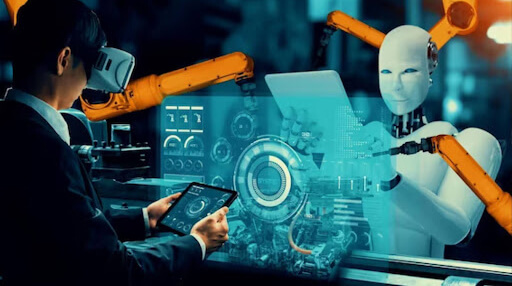The Future of Product Management and Product Engineering Practices in 2024 and Beyond.

Product engineering and product management are set to experience radical changes in the coming years due to the rapidly changing nature of technology and innovation. Knowing how these practices will develop is critical for organizations that want to stay ahead of the curve and satisfy the demands of a more complex market.
This blog closely examines the future of product engineering and management, examining their definitions, changing landscapes, and critical roles in propelling business success.
What is Product Management?
Product management encompasses the strategic planning, development, and optimization of products or services throughout their lifecycle. It involves understanding market needs, defining product features, and collaborating with cross-functional teams to deliver solutions that resonate with customers.
Product management bridges business strategy and product development, ensuring alignment with organizational goals and customer expectations.
What is Product Engineering?
Product engineering focuses on the technical aspects of product development, encompassing design, implementation, testing, and maintenance. It involves leveraging engineering principles and methodologies to create innovative, high-quality products that meet user requirements.
Product engineers work closely with product managers and other stakeholders to translate ideas into tangible products, driving the technical execution of the product roadmap.

Evolving Trends in Product Management
Product managers must be aware of new trends that will influence their industry and practice in the future if they want to stay on top of things. Let’s examine four crucial areas that are changing the face of product management:
A. Agile and Lean Principles: Embracing Flexibility and Efficiency
Gone are the days of waterfall development and lengthy product cycles. Agile and lean methodologies have become the norm, emphasizing iterative development, rapid experimentation, and continuous improvement. Product managers are adopting these principles to:
- Quickly adapt to shifting consumer needs and market demands.
- Minimize waste and maximize ROI by focusing on features that truly deliver value.
- Empower cross-functional teams to collaborate effectively and deliver products faster.
B. Integration of AI and Machine Learning: Leveraging Data-Driven Insights
Product design and management are changing due to advances in machine learning and artificial intelligence (AI/ML). Product managers are using AI and ML to:
- Gain deeper customer insights through sentiment analysis, predictive modeling, and personalized recommendations.
- Automate repetitive tasks like A/B testing and data analysis, freeing time for strategic thinking.
- Develop intelligent products that adapt to user behavior and offer personalized experiences.
C. Customer-Centric Approach: Putting Users at the Forefront
In today’s customer-centric world, understanding and meeting user needs is paramount. Product managers are focusing on:
- User research and empathy to deeply understand user pain points, motivations, and behaviors.
- Data-driven decision-making using quantitative and qualitative data to inform product decisions.
- Building a community around the product by actively engaging with users and incorporating their feedback.
D. Cross-Functional Collaboration:
No product exists in a vacuum. Successful product management demands close collaboration with various teams, including engineering, design, marketing, and sales. Today’s product managers are:
- Mastering communication and collaboration skills to bridge the gap between different disciplines.
- Fostering enduring connections with all of the organization’s stakeholders.
- Championing a shared vision for the product and driving alignment across teams.
Also Read: The Benefits of Cross-functional Teams in Product Engineering.

Advancements in Product Engineering Practices
The world of product development is in constant motion, propelled by technological advancements and ever-evolving customer needs. Product engineering is crucial in this dynamic landscape as the bridge between product vision and market reality. Let’s explore some key advancements transforming product engineering practices:
A. DevOps and Continuous Integration/Continuous Deployment (CI/CD):
Separate development and deployment teams are a thing of the past. Development and operations are no longer separated by silos thanks to DevOps. When paired with CI/CD pipeline, it permits:
- Frequent code integration and testing, catching bugs early, and reducing costly rework.
- Automated deployments, streamlined release processes, and reduced time to market.
- Improved collaboration and communication, leading to faster problem-solving and innovation.
B. Automation and AI-driven Development: Powering Efficiency and Insights
Repetitive tasks are getting a makeover with automation. By automating tasks like testing, documentation, and infrastructure management, product engineers can focus on:
- Higher-level strategic thinking and innovation.
- Personalizing customer experiences.
- Extracting meaningful insights from data.
AI is further transforming the game, helping with:
- Predictive maintenance and proactive issue resolution.
- Code generation and optimization.
- Real-time performance monitoring and anomaly detection.
C. Shift toward Microservices Architecture: Fostering Agility and Resilience
Traditional monolithic structures have given way to microservices architectures featuring smaller, independent, and self-contained services. This shift enables:
- Faster development and deployment as teams can work on different services independently.
- Increased scalability and resilience as individual services can be scaled or updated without impacting the entire system.
- Improved fault isolation as issues in one service won’t cascade through the entire system.
D. Emphasis on Scalability and Performance Optimization: Meeting growing demands
with ever-increasing user bases and complex functionalities, scalability and performance are paramount. Product engineers are focusing on:
- Utilizing cloud-based infrastructure for on-demand resources and flexible scaling.
- Implementing performance optimization techniques like caching, load balancing, and code profiling.
- Monitoring and analyzing system performance to identify bottlenecks and optimize resource utilization.

Impact of Emerging Technologies
A. Agile and Lean Principles in Product Management:
Adopting Agile and Lean principles revolutionizes product management, allowing teams to iterate rapidly, respond to market feedback, and deliver value incrementally. With Agile methodologies, product managers can prioritize features based on customer needs, ensuring maximum ROI and minimizing time to market.
Lean principles further enhance efficiency by eliminating waste and optimizing processes, enabling teams to focus on delivering high-quality products that meet evolving customer demands.
B. Integration of AI and Machine Learning:
Integrating AI and machine learning technologies empowers product managers and engineers to unlock valuable insights from data, enabling data-driven decision-making and predictive analytics.
By leveraging AI algorithms, product managers can personalize user experiences, optimize product recommendations, and automate repetitive tasks, ultimately enhancing customer satisfaction and driving revenue growth. Machine learning algorithms also enable predictive maintenance in engineering, reducing downtime and improving overall product reliability.
C. Customer-Centric Approach:
Using a customer-centric approach that prioritizes user needs and preferences during product development and engineering is made possible by emerging technologies for product management and engineering teams.
Product managers are better able to understand user behavior and preferences through the use of advanced analytics and customer feedback mechanisms. This enables them to customize products to specific customer needs. Businesses prioritizing customer engagement and satisfaction can gain an edge in the market and cultivate a base of devoted customers.
D. Cross-Functional Collaboration:
Emerging technologies facilitate cross-functional collaboration between product management, engineering, marketing, and other departments, fostering a culture of teamwork and innovation.
Collaboration tools and platforms enable seamless communication and knowledge sharing, breaking down silos and facilitating alignment around common goals. By promoting cross-functional collaboration, organizations can accelerate product development cycles, drive innovation, and deliver exceptional experiences that delight customers.

Future Outlook
Product management and engineering landscapes are constantly in flux, shaped by emerging technologies, evolving customer expectations, and ever-shifting market dynamics. Let’s explore four transformative currents shaping the future outlook of this symbiotic relationship:
A. Convergence of Product Management and Engineering:
Historically, product management and engineering functioned as separate entities, often leading to misalignment and communication hurdles. The future, however, points towards a convergence of these disciplines. This means:
- Shared ownership and responsibility: Both sides will collaborate more closely, understanding each other’s challenges and working together to create solutions.
- Joint problem-solving and ideation: Product managers will gain technical fluency, while engineers will develop more robust business acumen, fostering cross-pollination of ideas.
- Shared metrics and goals: Teams will focus on common objectives, measuring success based on user impact and value delivered, not just individual milestones.
If achieved effectively, this convergence can streamline product development, accelerate innovation, and ultimately deliver products that resonate with users.
B. Continued Evolution toward Customer-Driven Solutions: Putting Users at the Center of Everything
While user-centricity is already a buzzword, the future demands deeper immersion into customer needs and desires. We can expect:
- Hyper-personalization: Leveraging AI and data analytics to tailor products and experiences to individual user preferences and contexts in real time.
- Customer-centric product roadmaps: Prioritizing features and functionalities based on direct user feedback and insights gathered through various channels.
- Co-creation with users: Engaging customers actively in ideation, testing, and development, blurring the lines between creator and consumer.
This user-driven approach will result in highly relevant, impactful, and emotionally engaging products, fostering deeper connections and driving long-term customer loyalty.
C. Importance of Flexibility and Adaptability in a Dynamic Market: Embracing Change as the New Normal
The speed of change in today’s markets is unprecedented. To thrive, both product managers and engineers must develop a more robust appetite for agility and adaptability:
- Experimentation and rapid prototyping: Testing new ideas quickly, failing fast, and iterating based on user feedback to find the winning solutions.
- Embracing emerging technologies: Continuously learning and upskilling to adapt to advancements in AI, automation, and other transformative areas.
- Building resilient and scalable architectures: Creating products that quickly adapt to changing user needs, market demands, and unforeseen challenges.
D. Role of Product Managers and Engineers as Strategic Leaders: Beyond Features and Functionalities
The future holds a vision where product managers and engineers transcend traditional roles, becoming strategic thought leaders within their organizations. This transformation involves:
- Deep understanding of the business: Possessing a solid grasp of market trends, competitive analysis, and the overall business landscape.
- Driving vision and innovation: Championing a clear vision for the product’s direction, inspiring teams, and guiding product evolution.
- Measuring and communicating impact: Going beyond technical metrics and communicating the product’s value proposition to stakeholders.
Future of Product Management and Engineering: Stats Painting the Big Picture
As we venture beyond 2024, the product development landscape continues to evolve rapidly. Let’s dive into some key statistics that illuminate the future trajectory of product engineering and management practices:
Market Growth and Adoption:
- Global product engineering services market: Projected to reach $720.84 billion by 2027, with a CAGR of 9.4% from 2022 to 2027.
- Product data management (PDM) software market: Expected to reach $50.8 billion by 2027, with a CAGR of 10.5% from 2022 to 2027.
- Organizations leveraging Agile & Lean methodologies: Expected to reach 98% by 2025, indicating widespread adoption.
Emerging Technologies and Trends:
- 5G-enabled devices: Predicted to reach 1.2 billion globally by 2025, opening doors for real-time applications and edge computing.
- Percentage of businesses utilizing AI in product development: Projected to reach 40% by 2025, highlighting its growing impact.
- Cloud adoption in product management: Forecast to reach 83% by 2025, driving agility and scalability.
Skillsets and Talent Shortages:
- Top emerging skills for product managers: Data analysis, AI understanding, and customer empathy. (Source: Product Alliance)
- Demand for software engineers: Expected to grow 26% from 2020 to 2030, creating talent gaps that need addressing.
- Reskilling and upskilling: Crucial for both product managers and engineers to stay relevant in the rapidly evolving market. (Source: McKinsey & Company)
Focus Areas and Priorities:
- Customer-centricity: 80% of businesses indicate that improving customer experience is a top priority.
- Security and data privacy: Top concern for businesses adopting new technologies, with a projected spending of $150.4 billion on cybersecurity in 2023.
- Sustainability: Growing pressure on organizations to develop environmentally friendly products and processes. (Source: Deloitte)

Summary
Product management and engineering will collaborate more closely in the coming years to drive innovation and provide customer value. Organizations can increase customer satisfaction, shorten time-to-market, and improve product quality by implementing agile methodologies, dismantling organizational silos, and encouraging closer collaboration amongst cross-functional teams.
In addition, a comprehensive approach to product management and engineering will be required due to the increasing prevalence of connected devices and the rise of digital transformation. This approach should consider software, hardware, and user experience factors.
Enterprises that prioritize ongoing education, flexibility, and an unwavering commitment to providing value to customers will prosper. Businesses may stay ahead of the curve and seize new opportunities in the quickly changing digital economy by investing in talent development, encouraging a culture of experimentation, and utilizing emerging technologies.
Ultimately, adopting change, fostering innovation, and unrelentingly pursuing excellence in delivering products that satisfy customers and propel business success will shape the future of product engineering and product management practices.
How can [x]cube LABS Help?
[x]cube LABS’s teams of product owners and experts have worked with global brands such as Panini, Mann+Hummel, tradeMONSTER, and others to deliver over 950 successful digital products, resulting in the creation of new digital lines of revenue and entirely new businesses. With over 30 global product design and development awards, [x]cube LABS has established itself among global enterprises’ top digital transformation partners.
Why work with [x]cube LABS?
- Founder-led engineering teams:
Our co-founders and tech architects are deeply involved in projects and are unafraid to get their hands dirty.
- Deep technical leadership:
Our tech leaders have spent decades solving complex technical problems. Having them on your project is like instantly plugging into thousands of person-hours of real-life experience.
- Stringent induction and training:
We are obsessed with crafting top-quality products. We hire only the best hands-on talent. We train them like Navy Seals to meet our standards of software craftsmanship.
- Next-gen processes and tools:
Eye on the puck. We constantly research and stay up-to-speed with the best technology has to offer.
- DevOps excellence:
Our CI/CD tools ensure strict quality checks to ensure the code in your project is top-notch.
Contact us to discuss your digital innovation plans, and our experts would be happy to schedule a free consultation!
![Blog-[x]cube LABS](https://d6fiz9tmzg8gn.cloudfront.net/wp-content/uploads/2016/06/blog_banner.jpg)





